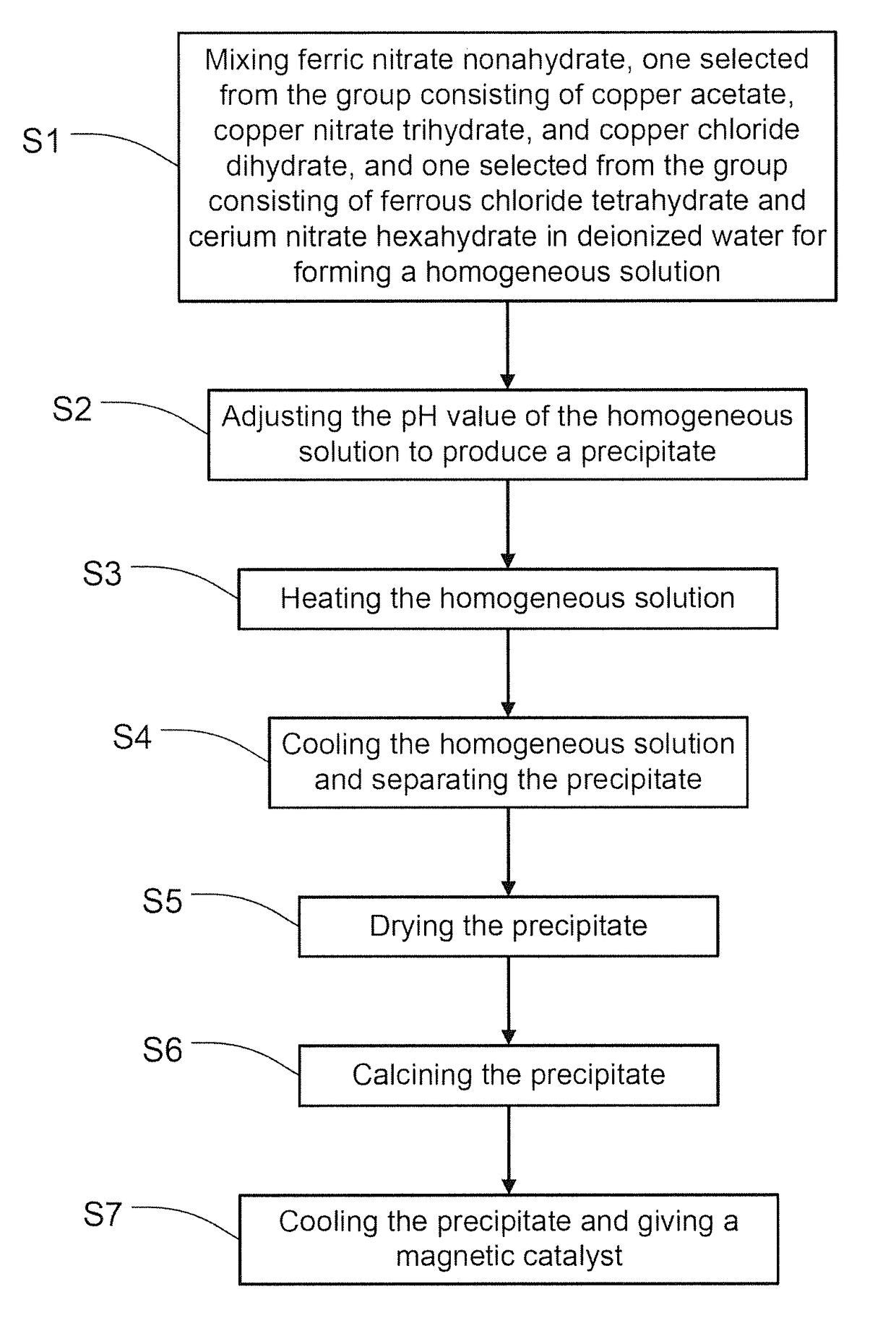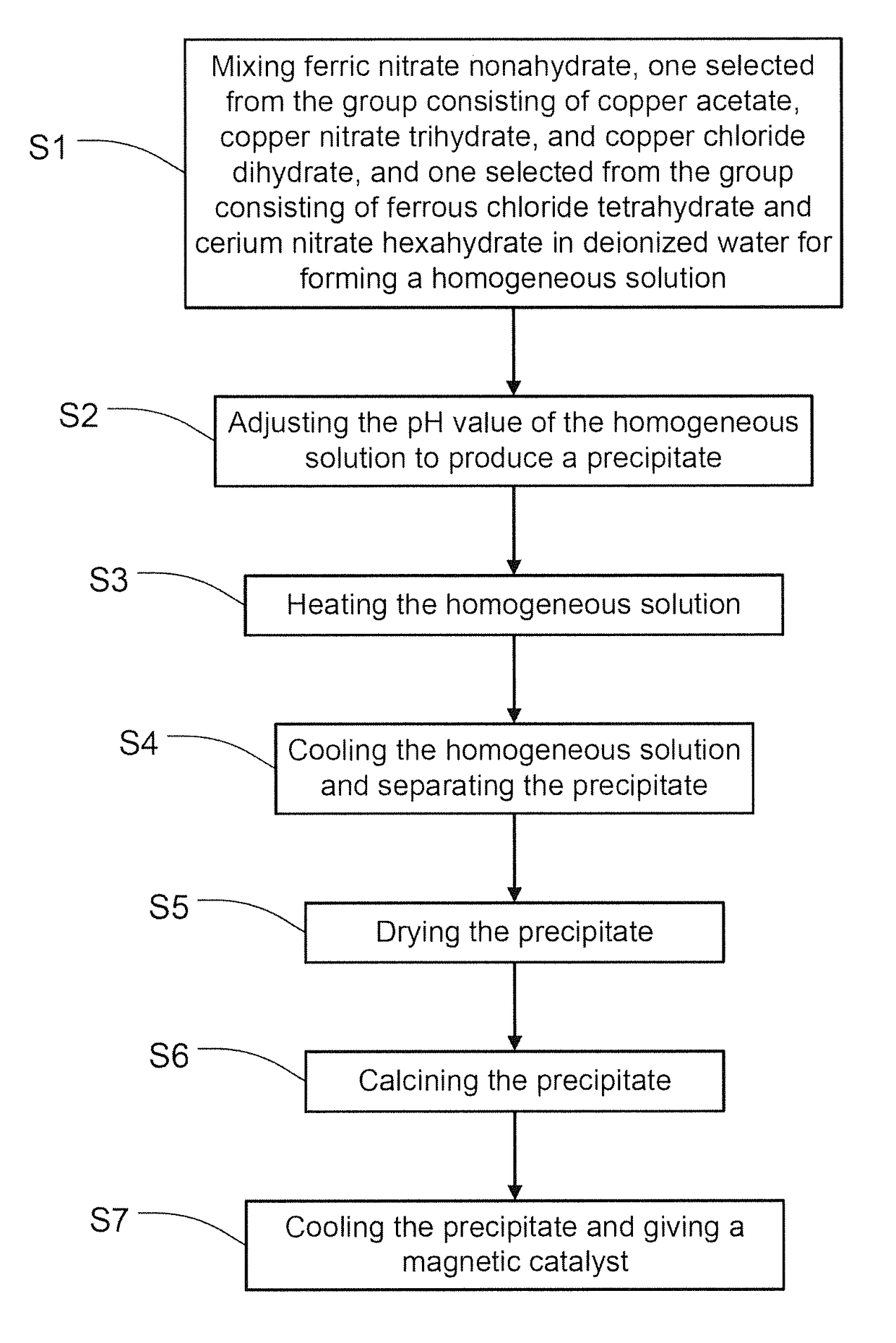Magnetic catalyst for wet oxidation of organic waste and preparation method thereof
a technology of wet oxidation and magnetization catalyst, which is applied in the direction of catalyst activation/preparation, metal/metal-oxide/metal-hydroxide catalyst, physical/chemical process catalyst, etc., can solve the problems of reducing oxidation efficiency, inevitably leaving behind secondary waste, and thoroughly destroying organic waste, etc., to save the cost of separating and treating secondary waste, simple separation procedure, and effective separation
- Summary
- Abstract
- Description
- Claims
- Application Information
AI Technical Summary
Benefits of technology
Problems solved by technology
Method used
Image
Examples
embodiment 1
[0040]Use about 10% methanol aqueous solution as the organic waste liquid (the initial TOC mass is 2968.2 mg). The experimental results of the amount of hydrogen peroxide used (Run 123), the adding flow rate of hydrogen peroxide (Run 35), the amount of the magnetic catalyst added (Run 367), and the total reaction time (Run 34) on the DRE are shown in Table 1. According to the experimental data, increasing the total amount of 50% hydrogen peroxide used in the reaction increases the DRE. In the process of Run 3, DRE can reach 99.97%. The concentration of total organic carbon in the solution after reaction is only 6.9 mg / L; its TOC mass is only 0.9 mg. In the cases of Run 3 and Run 5, the DRE can reach over 99% when the volume flow rates of the added hydrogen peroxide are 2.5 mL / min and 5.0 mL / min, respectively. According to the present embodiment, the effect of the amount of the magnetic catalyst added in the reaction on the DRE is also examined. The results show that without the magn...
embodiment 2
[0042]Another feature of the magnetic catalyst according to the present invention is that it can be repeatedly applied to wet oxidation reaction without activity decay. Thereby, the performance of repeated usage of the magnetic catalyst according to the present invention is also tested, as shown in Table 2. After 11 times of continual tests, the DRE can all reach above 99.9%. The result proves that the magnetic catalyst prepared according to the present invention can be reused effectively.
[0043]
TABLE 2CTOCWTOCDRERun(mg / L)(mg)(%) 1st8.291.3399.96 2nd8.701.4099.95 3rd8.251.3399.96 4th7.341.2499.96 5th7.961.2799.96 6th8.621.3999.95 7th8.401.3799.95 8th7.301.1899.96 9th8.311.3499.9510th7.971.3899.9511th7.661.3799.95
Organic waste liquid: 10% MeOH, 100 mL, initial TOC=29,682 mg / L;
Oxidant: 50% H2O2, 80 mL, 2.5 mL / min;
Catalyst: Magnetic catalyst, 2 g;
Reaction temperature: 95˜100° C.;
Reaction time: 120 min.
embodiment 3
[0044]According to the present invention, experiments have been conducted for treating organic liquid radioactive waste by wet oxidation reaction (TOC concentration is 25,000 mg / L), as shown in Table 3. After reacting for 120 minutes, the DRE can reach 98%. Compared with the conventional Fenton reaction using ferrous ion aqueous solution, there is no precipitate of ferric hydroxide produced in the reaction. By using the magnetic catalyst prepared according to the present invention in wet oxidation reaction, organic liquid radioactive waste can be treated effectively and the secondary waste such as precipitates of ferric hydroxide can be eliminated. In addition, the magnetic devices can be used for separating the catalyst from the reaction solution quite easily.
[0045]
TABLE 3MOC Catalyst50% H2O2TimeTOCDREExp.(g)(mL)(min)(mg / L)(%)Heterogeneous2.08060323087.08Catalyst12048198.08
[0046]By employing the steps described above, a magnetic catalyst is prepared according to the present inventi...
PUM
| Property | Measurement | Unit |
|---|---|---|
| diameter | aaaaa | aaaaa |
| COD | aaaaa | aaaaa |
| temperature | aaaaa | aaaaa |
Abstract
Description
Claims
Application Information
 Login to View More
Login to View More - Generate Ideas
- Intellectual Property
- Life Sciences
- Materials
- Tech Scout
- Unparalleled Data Quality
- Higher Quality Content
- 60% Fewer Hallucinations
Browse by: Latest US Patents, China's latest patents, Technical Efficacy Thesaurus, Application Domain, Technology Topic, Popular Technical Reports.
© 2025 PatSnap. All rights reserved.Legal|Privacy policy|Modern Slavery Act Transparency Statement|Sitemap|About US| Contact US: help@patsnap.com



